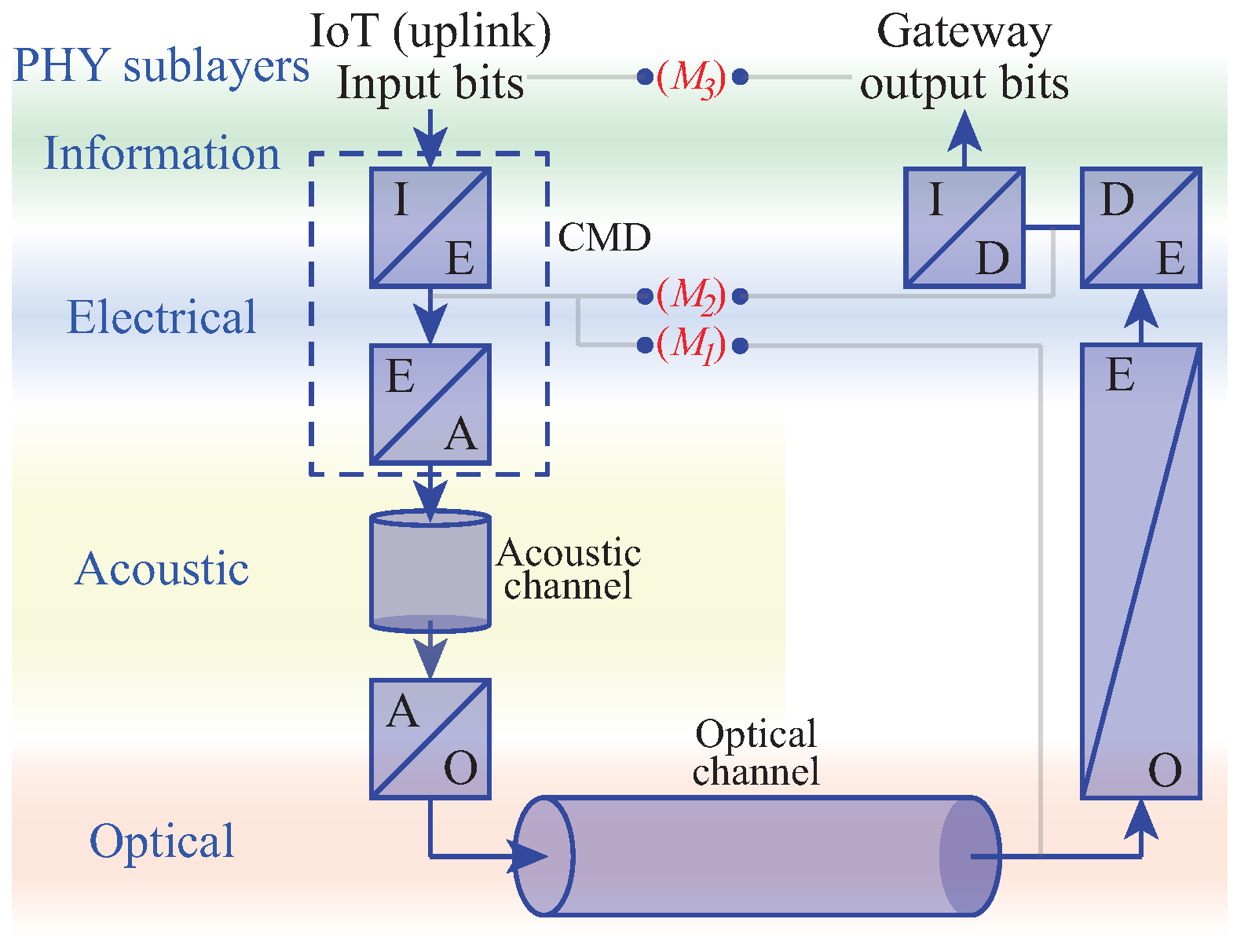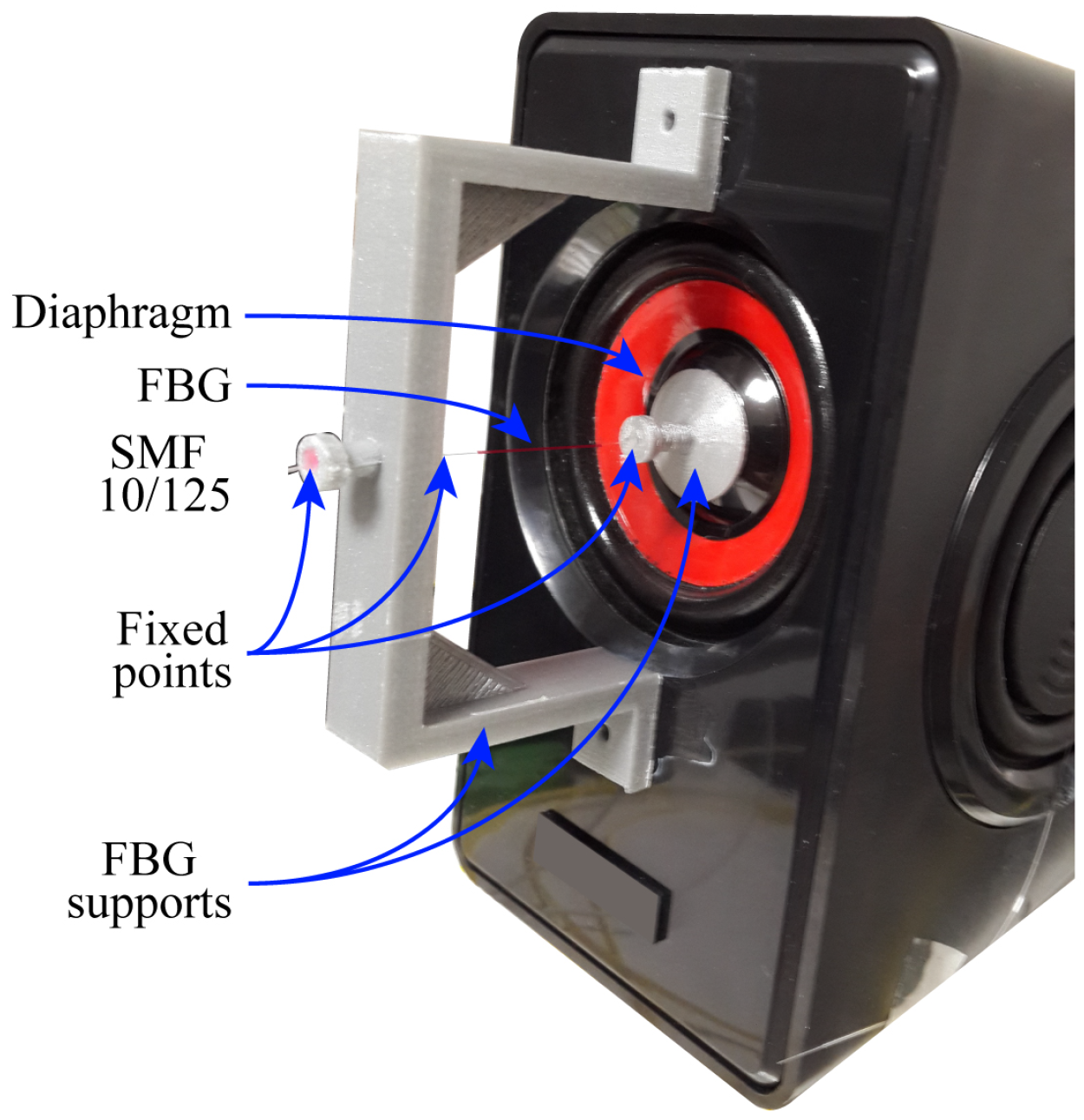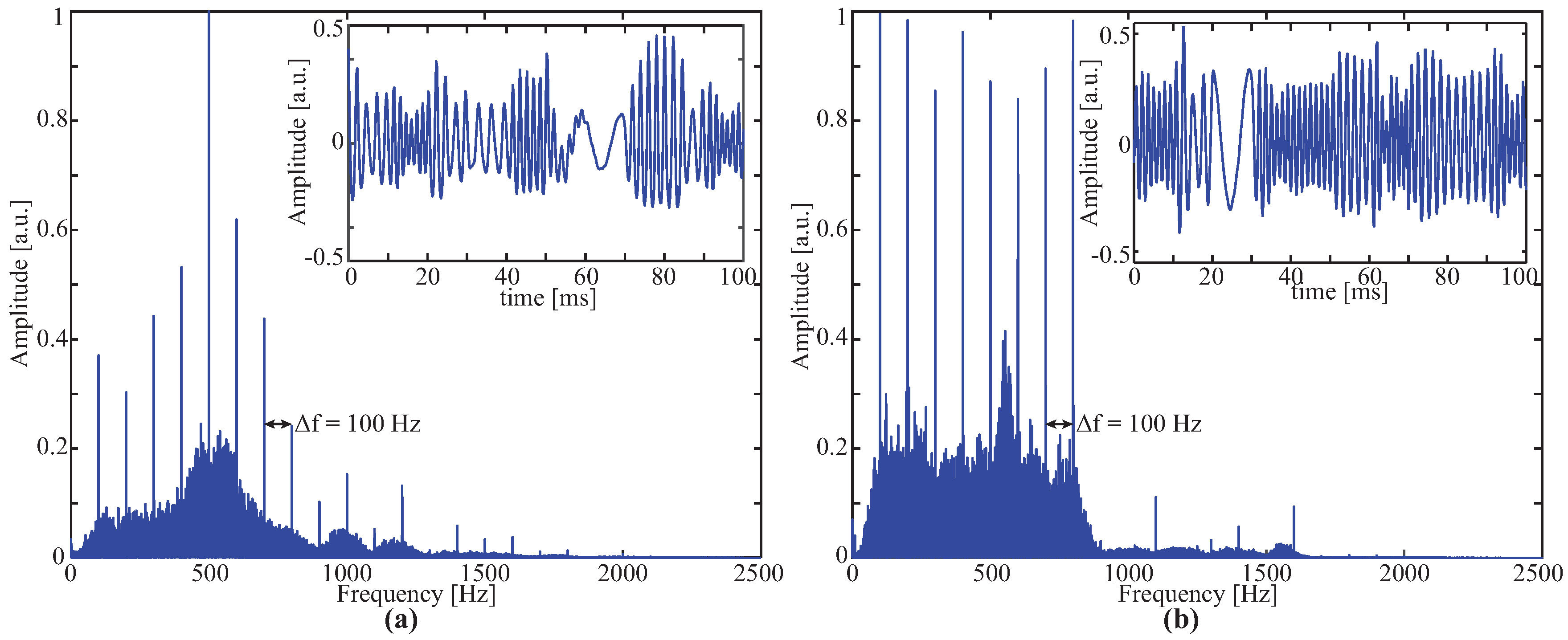IoToF: A Long-Reach Fully Passive Low-Rate Upstream PHY for IoT over Fiber
Abstract
1. Introduction
2. Materials and Methods
2.1. IoT Connectivity
2.2. The Role of Optical Connectivity in IoT
2.3. Requirements for IoT over Fiber (IoToF)
2.4. FBG-Based IoToF: A Fully Passive Optical Architecture
2.5. IoToF Prototype Implementation
2.5.1. Acoustic-to-Optical Module
2.5.2. Electrical-to-Acoustic Module, Acoustic Channel, and Digital Modulation Strategy
2.5.3. Optical-to-Electrical Module and Demodulation Strategy
2.5.4. Experimental Setup and System Characterization
3. Results
3.1. Edge-Filtering Optical-to-Electrical Characterization ( Vs. )
3.2. Analog Communication Channel Characterization ()
3.2.1. Interaction of Codification-Modulation Device with Communication Channel
3.2.2. Electrical-to-Digital and Digital-to-Information Conversion Issues
3.3. Digital Communication Channel Characterization ()
4. Conclusions
Author Contributions
Funding
Acknowledgments
Conflicts of Interest
References
- Tokognon, C.A.; Gao, B.; Tian, G.Y.; Yan, Y. Structural Health Monitoring Framework Based on Internet of Things: A Survey. IEEE Internet Things J. 2017, 4, 619–635. [Google Scholar] [CrossRef]
- Catarinucci, L.; de Donno, D.; Mainetti, L.; Palano, L.; Patrono, L.; Stefanizzi, M.L.; Tarricone, L. An IoT-Aware Architecture for Smart Healthcare Systems. IEEE Internet Things J. 2015, 2, 515–526. [Google Scholar] [CrossRef]
- Kulkarni, A.; Sathe, S. Healthcare applications of the Internet of Things: A Review. Int. J. Comput. Sci. Inf. Technol. 2014, 5, 6229–6232. [Google Scholar]
- Zanella, A.; Bui, N.; Castellani, A.; Vangelista, L.; Zorzi, M. Internet of Things for Smart Cities. IEEE Internet Things J. 2014, 1, 22–32. [Google Scholar] [CrossRef]
- Lee, S. Communication Technology and Application of Internet of Things (IoT) in Smart Home Environment. Int. J. Comput. Appl. 2017, 10, 397–404. [Google Scholar] [CrossRef]
- Madakam, S.; Ramaswamy, R.; Tripathi, S. Internet of Things (IoT): A Literature Review. J. Comput. Commun. 2015, 3, 164–173. [Google Scholar] [CrossRef]
- Shang, Y. Vulnerability of networks: Fractional percolation on random graphs. Phys. Rev. E 2014, 89, 012813. [Google Scholar] [CrossRef] [PubMed]
- Wydra, M.; Kisala, P.; Harasim, D.; Kacejko, P. Overhead Transmission Line Sag Estimation Using a Simple Optomechanical System with Chirped Fiber Bragg Gratings. Part 1: Preliminary Measurements. Sensors 2018, 18, 309. [Google Scholar] [CrossRef] [PubMed]
- Díaz, C.A.R.; Leal-Junior, A.G.; Andrdé, P.S.B.; da Costa Antunes, P.F.; Pontes, M.J.; Frizera-Neto, A.; Ribeiro, M.R.N. Liquid Level Measurement Based on FBG-Embedded Diaphragms with Temperature Compensation. IEEE Sens. J. 2018, 18, 193–200. [Google Scholar] [CrossRef]
- da Silva Marques, R.; Prado, A.R.; da Costa Antunes, P.F.; de Brito André, P.S.; Ribeiro, M.; Frizera-Neto, A.; Pontes, M.J. Corrosion Resistant FBG-based quasi-distributed sensor for crude oil tank dynamic temperature profile monitoring. Sensors 2015, 15, 30693–30703. [Google Scholar] [CrossRef] [PubMed]
- Díaz, C.A.; Marques, C.A.; Domingues, M.F.F.; Ribeiro, M.R.; Frizera-Neto, A.; Pontes, M.J.; André, P.S.; Antunes, P.F. A cost-effective edge-filter based FBG interrogator using catastrophic fuse effect micro-cavity interferometers. Measurement 2018, 124, 486–493. [Google Scholar] [CrossRef]
- Díaz, C.A.R.; Leitão, C.; Marques, C.A.; Domingues, M.F.; Alberto, N.; Pontes, M.J.; Frizera, A.; Ribeiro, M.R.N.; André, P.S.B.; Antunes, P.F.C. Low-Cost Interrogation Technique for Dynamic Measurements with FBG-Based Devices. Sensors 2017, 17, 2414. [Google Scholar] [CrossRef] [PubMed]
- Al-Sarawi, S.; Anbar, M.; Alieyan, K.; Alzubaidi, M. Internet of Things (IoT) communication protocols: Review. In Proceedings of the 2017 8th International Conference on Information Technology (ICIT), Amman, Jordan, 17–18 May 2017; pp. 685–690. [Google Scholar]
- Lethaby, N. Wireless Connectivity for the Internet of Things: One Size Does Not Fit All; Technical Report; Texas Instruments: Dallas, TX, USA, 2017. [Google Scholar]
- Mainetti, L.; Patrono, L.; Vilei, A. Evolution of wireless sensor networks towards the Internet of Things: A survey. In Proceedings of the SoftCOM 2011, 19th International Conference on Software, Telecommunications and Computer Networks, Split, Croatia, 15–17 September 2011; pp. 1–6. [Google Scholar]
- Atzori, L.; Iera, A.; Morabito, G. The Internet of Things: A survey. Comput. Netw. 2010, 54, 2787–2805. [Google Scholar] [CrossRef]
- Li, B.; Yu, J. Research and Application on the Smart Home Based on Component Technologies and Internet of Things. Procedia Eng. 2011, 15, 2087–2092. [Google Scholar] [CrossRef]
- Borgia, E. The Internet of Things vision: Key features, applications and open issues. Comput. Commun. 2014, 54, 1–31. [Google Scholar] [CrossRef]
- Guibene, W.; Nolan, K.E.; Kelly, M.Y. Survey on Clean Slate Cellular-IoT Standard Proposals. In Proceedings of the 2015 IEEE International Conference on Computer and Information Technology; Ubiquitous Computing and Communications; Dependable, Autonomic and Secure Computing; Pervasive Intelligence and Computing, Liverpool, UK, 26–28 October 2015; pp. 1596–1599. [Google Scholar]
- Wydra, M.; Kubaczynski, P.; Mazur, K.; Ksiezopolski, B. Time-Aware Monitoring of Overhead Transmission Line Sag and Temperature with LoRa Communication. Energies 2019, 12, 505. [Google Scholar] [CrossRef]
- Mazur, K.; Wydra, M.; Ksiezopolski, B. Secure and Time-Aware Communication of Wireless Sensors Monitoring Overhead Transmission Lines. Sensors 2017, 17, 1610. [Google Scholar] [CrossRef] [PubMed]
- Senior, J.M. Optical Fiber Communications Principles and Practice, 3rd ed.; Pearson Education: London, UK, 2009. [Google Scholar]
- Ji, P.N.; Wang, T. Internet of things with optical connectivity, networking, and beyond. In Proceedings of the 2016 21st OptoElectronics and Communications Conference (OECC) Held Jointly with 2016 International Conference on Photonics in Switching (PS), Niigata, Japan, 3–7 July 2016; pp. 1–3. [Google Scholar]
- Sanctis, M.D.; Cianca, E.; Araniti, G.; Bisio, I.; Prasad, R. Satellite Communications Supporting Internet of Remote Things. IEEE Internet Things J. 2016, 3, 113–123. [Google Scholar] [CrossRef]
- Larsen, C.P.; Gavler, A.; Wang, K. Comparison of active and passive optical access networks. In Proceedings of the 2010 9th Conference of Telecommunication, Media and Internet, Ghent, Belgium, 7–9 June 2010; pp. 1–5. [Google Scholar]
- Vetter, P.; Suvakovic, D.; Chow, H.; Anthapadmanabhan, P.; Kanonakis, K.; Lee, K.L.; Saliou, F.; Yin, X.; Lannoo, B. Energy-efficiency improvements for optical access. IEEE Commun. Mag. 2014, 52, 136–144. [Google Scholar] [CrossRef]
- Haslett, C. Essentials of Radio Wave Propagation, 1st ed.; Cambridge University Press: Cambridge, UK, 2008. [Google Scholar]
- Winder, S.; Carr, J.J.; Davies, J. Newnes Radio and RF Engineering Pocket Book, 3rd ed.; Elsevier: Amsterdam, The Netherlands, 2002. [Google Scholar]
- Skubic, B.; de Betou, E.I.; Ayhan, T.; Dahlfort, S. Energy-efficient next-generation optical access networks. IEEE Commun. Mag. 2012, 50, 122–127. [Google Scholar] [CrossRef]
- Yan, L.; Wu, Z.; Zhang, Z.; Pan, W.; Luo, B.; Wang, P. High-Speed FBG-Based Fiber Sensor Networks for Semidistributed Strain Measurements. IEEE Photonics J. 2013, 5, 7200507. [Google Scholar]
- Pachava, V.R.; Kamineni, S.; Madhuvarasu, S.S.; Putha, K.; Mamidi, V.R. FBG based high sensitive pressure sensor and its low-cost interrogation system with enhanced resolution. Photonic Sens. 2015, 5, 321–329. [Google Scholar] [CrossRef]
- Srivastava, D.; Bhatnagar, R.; Kumar, A.; Parmar, V. Intensity modulation using chirped fiber bragg grating as an edge filter for temperature sensing. Microw. Opt. Technol. Lett. 2014, 56, 2913–2915. [Google Scholar] [CrossRef]
- Guo, T.; Tam, H.Y.; Albert, J. Chirped and tilted fiber Bragg grating edge filter for in-fiber sensor interrogation. In CLEO: Science and Innovations; Optical Society of America: Washington, DC, USA, 2011; p. CThL3. [Google Scholar]
- Tiwari, U.; Thyagarajan, K.; Shenoy, M.R.; Jain, S.C. EDF-Based Edge-Filter Interrogation Scheme for FBG Sensors. IEEE Sens. J. 2013, 13, 1315–1319. [Google Scholar] [CrossRef]
- Wei, L.; Khattak, A.; Martz, C.; Zhou, D.P. Tunable Multimode Fiber Based Filter and Its Application in Cost-Effective Interrogation of Fiber-Optic Temperature Sensors. IEEE Sens. J. 2017, 9, 1–8. [Google Scholar] [CrossRef]
- Proakis, J.G.; Salehi, M.; Bauch, G. Contemporary Communication Systems Using MATLAB, 3rd ed.; Nelson Education: Scarborough, ON, Canada, 2013. [Google Scholar]
- Peucheret, C.; Liu, F.; Pedersen, R.J.S. Measurement of small dispersion values in optical components [WDM networks]. Electron. Lett. 1999, 35, 409–411. [Google Scholar] [CrossRef]
- CC1120 High-Performance RF Transceiver for Narrowband Systems; Technical Report; Texas Instruments: Dallas, TX, USA, 2015.
- Hayashi, G.; Sawada, A.; Morie, T.; Matsuyama, K.; Kim, R.; Yoshida, S.; Matsumoto, A.; Hijikata, K.; Matsukawa, K.; Tamura, Y.; et al. A 10.8mA Single Chip Transceiver for 430MHz Narrowband Systems in 0.15/spl mu/m CMOS. In Proceedings of the 2006 IEEE International Solid State Circuits Conference—Digest of Technical Papers, San Francisco, CA, USA, 6–9 February 2006; pp. 1480–1489. [Google Scholar]
- André, P.; Lima, M.J.N.; Rocha, A.M.; Fernandes, N.; Granada, M.; Almeida, T.; Chang, J.; Lan, R.; Xin, X.-J. Raman amplified access networks with pump signal recycling for electrical power conversion. Microw. Opt. Technol. Lett. 2012, 54, 116–119. [Google Scholar] [CrossRef]









| IoT Requiriments | Conventional Optical PHY @ ONU (per Subscriber [26]) | IoToF Optical PHY |
|---|---|---|
| Throughput | Up to 2.5 Gbps | At least 100 bps |
| Range | Up to 20 km | At least 20 km |
| Power Consumption | Around 1 W | 0 W () |
© 2019 by the authors. Licensee MDPI, Basel, Switzerland. This article is an open access article distributed under the terms and conditions of the Creative Commons Attribution (CC BY) license (http://creativecommons.org/licenses/by/4.0/).
Share and Cite
Díaz, C.A.R.; Leitão, C.; Marques, C.A.; Alberto, N.; Domingues, M.F.; Ribeiro, T.; Pontes, M.J.; Frizera, A.; Antunes, P.F.C.; André, P.S.; et al. IoToF: A Long-Reach Fully Passive Low-Rate Upstream PHY for IoT over Fiber. Electronics 2019, 8, 359. https://doi.org/10.3390/electronics8030359
Díaz CAR, Leitão C, Marques CA, Alberto N, Domingues MF, Ribeiro T, Pontes MJ, Frizera A, Antunes PFC, André PS, et al. IoToF: A Long-Reach Fully Passive Low-Rate Upstream PHY for IoT over Fiber. Electronics. 2019; 8(3):359. https://doi.org/10.3390/electronics8030359
Chicago/Turabian StyleDíaz, Camilo A. R., Cátia Leitão, Carlos A. Marques, Nélia Alberto, M. Fátima Domingues, Tiago Ribeiro, Maria J. Pontes, Anselmo Frizera, Paulo F.C. Antunes, Paulo S. André, and et al. 2019. "IoToF: A Long-Reach Fully Passive Low-Rate Upstream PHY for IoT over Fiber" Electronics 8, no. 3: 359. https://doi.org/10.3390/electronics8030359
APA StyleDíaz, C. A. R., Leitão, C., Marques, C. A., Alberto, N., Domingues, M. F., Ribeiro, T., Pontes, M. J., Frizera, A., Antunes, P. F. C., André, P. S., & Ribeiro, M. R. N. (2019). IoToF: A Long-Reach Fully Passive Low-Rate Upstream PHY for IoT over Fiber. Electronics, 8(3), 359. https://doi.org/10.3390/electronics8030359












